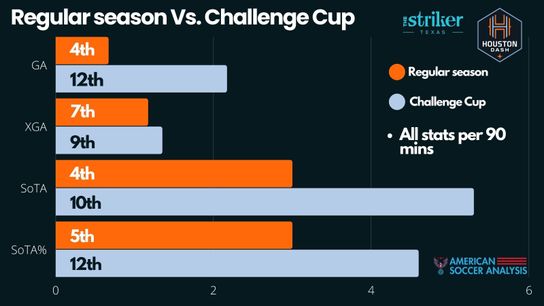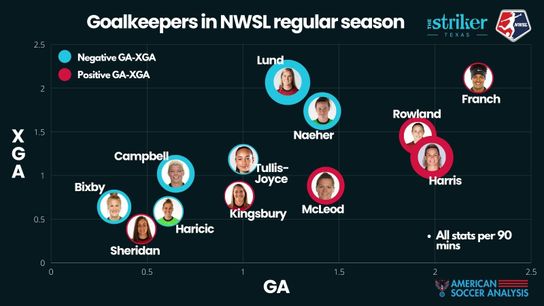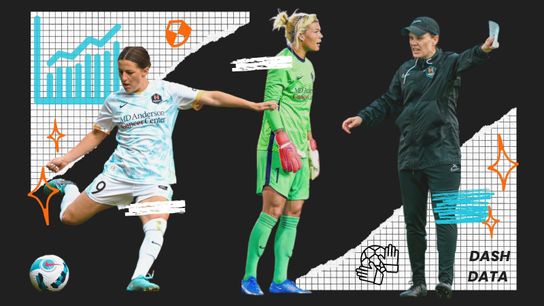Houston, you had a problem.
For the first couple of months of the 2022 season during the Challenge Cup group stages, the Houston Dash had one of the worst defenses in the NWSL — both statistically speaking and in terms of errors.
Now three matches into the regular season, the Dash has not only improved its defense record but recent impressive performances suggest that this team can be an upper-tier defensive unit in the NWSL.
Let’s take a look at some of the data and see what has changed:

In the chart above, the number on the colored bars represent where Houston ranked in the NWSL for each particular chosen statistic. The rankings are out of 12, because there are 12 teams in the league.
It is quite startling to see how drastic the improvement has been since the NWSL regular season began on May 1. In all four of the most general defensive statistics highlighted — GA (goals against), XGA (expected goals against), SoTA (shots on target against), SoTA% (shots on target against percentage of total shots) — the Dash have made significant gains in just a matter of weeks. All statistics are taken from American Soccer Analysis.
The biggest ranking jump has been in goals against. Since the start of the regular season, the Dash have reduced its concession rate by over 300%, going from an average of 2.17 goals per match in the Challenge Cup to 0.67 in the regular season.
On the face of it, there’s three explanations from the data for this surge.
Firstly, the Dash has severely cut down on allowing its opponents to attempt shots on target. As you can see on the chart, Houston went from ranking tenth to a much more respectable fourth in the league for that data point. Similarly, the percentage of the opponent’s total shots that were on target against the Dash has come down from 46% to 30% (or from last place to fifth place) during the regular season.
Growth in these statistics reflect how the overall defensive unit has started performing at a much higher level.
Defenders have been blocking shots and holding their shape in the box, midfielders have been stepping into passing lanes and forwards have been pressing the opposition in the front line. It has been a group effort — for the most part — to see this type of reduction.
Secondly, Houston has settled on a first-choice backline since the Challenge Cup finished. The early matches of the season were littered with personnel changes at the back. A good defensive unit is all about continuity.
A big question after Megan Montefusco departed in the offseason was who would play center back. After initially experimenting with Sophie Schmidt and then Julia Ashley alongside Katie Naughton, eventually Ally Prisock returned from her loan in France and won the starting spot. The Dash have been more solid ever since.
Thirdly, Dash goalkeeper Jane Campbell has become much more reliable at blocking the shots that do make it through to the Houston goal. She deserves some extra credit for stepping up and making big saves.
During the Challenge Cup, Campbell faced 29 shots on target, the second-most of any goalkeeper in the NWSL. She saved 17 of those 29 shots for a save percentage of 61%, ranking 14th out of the 16 goalkeepers that appeared in the Challenge Cup in terms of save percentage — a common data point for analyzing goalkeepers.
The former USWNT shot stopper knew she could be better than this. "I think selfishly for me this year is important," said Campbell before the NWSL regular season began on May 1. "We need to get some shutouts and we need to start winning games. That is my responsibility: getting shutouts. If we don’t concede, then we have a chance of winning games. I know the Challenge Cup was rough for us, I am glad to get the wrinkles out then and not in the year."
What’s interesting is that not only is Campbell having less saves to make since the regular season started, but she is also stopping shots at a higher rate. Campbell’s save percentage has risen to 78%, which ranks fourth in the NWSL, over the first three matches of the regular season.
The most telling statistic that proves Campbell’s upswing in performance is G-XGA. During the Challenge Cup, the Dash were actually significantly underperforming its expected defensive intake.
Houston managed to concede 13 goals across six matches despite its XGA being just 8.13. In other words, saveable or avoidable shots ended up in the back of the Dash net. This could be down to individual errors or perhaps a bit of luck for Houston’s opponents.
Now in the regular season, Campbell and the Dash are outperforming their XGA in the other direction. Houston has conceded a stingy two goals from an XGA of 3.19.

This scatter chart (above) measures how all the goalkeepers in the NWSL have started the regular season in terms of GA and XGA. The colored rings around each keeper visualize how impressive each player's GA-XGA has been. The bigger the ring, the higher GA-XGA value. Blue for negative value (which is what goalkeepers want) and red for positive value (which is what goalkeepers do not want).
Essentially, the graph shows how many goals a goalkeeper should be conceding versus how many they are conceding in reality. The graph shows how a player like Bella Bixby, who has conceded the fewest goals in the NWSL regular season, is still in an expected range of concession. Bixby is currently over performing her XGA narrowly by 0.29.
As you can see, Campbell has one of the better GA-XGA values in the league, currently behind only Alyssa Naeher and Katie Lund. That means Campbell is contributing to getting the Dash's GA statistic down to where it currently lies.
Have coaching changes been the difference?
An interesting wrinkle to Houston's uptick in defense is the coaching changes that have happened at the club. The Dash's defensive resurgence comes after James Clarkson was suspended by the NWSL. So far the Dash's acting head coach Sarah Lowdon has shown herself to be a defense-minded manager. Although tactically she hasn't veered too far away from Clarkson's model, she has tasked the Dash players with a more cautious approach.
Under Lowdon, the Dash does not over commit on attacks and tends to sit deeper in the midfield and wide positions. Crucially, Houston has stopped conceding from set pieces, and is better in defensive transition. However, the team has a penchant for conceding late and when crosses come in from the left hand side of the defense.
It's definitely too early to know exactly what sort of coach Lowdon is or wants to be, or even how she differs from Clarkson at this point. Her ability to steady the ship and calm the players off the pitch has certainly had a similar effect on the pitch. We will be watching her coaching development closely. At the very least, Lowdon deserves immense credit for creating a positive environment and winning back the locker room at a tense moment for the Houston club.
Aside from Lowdon, it is worth noting that after the first five matches of the Challenge Cup, the Dash also made a change at goalkeeper coach with Matt Lampson stepping in to replace Brenton Saylor. It might also be too soon to heap too much praise on Lampson, but the change appears to have sparked something in Campbell's performance levels for now.
✨Official: Matt Lampson is the new goalkeeper coach for the Houston Dash.
— Theo Lloyd-Hughes (@theodore_LH) May 13, 2022
🧤Replaced Brenton Saylor midway through Challenge Cup.
10 year #MLS career ended in 2021. A cancer survivor and founder of @LampStrong foundation. #NWSL pic.twitter.com/fQRlVMKofV
